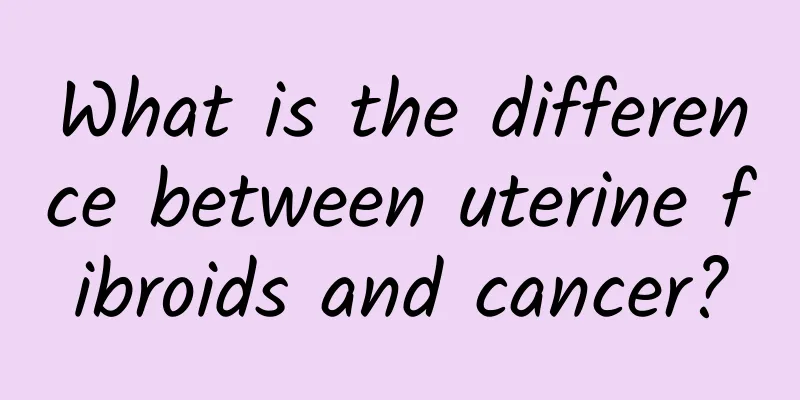What is the difference between uterine fibroids and cancer?

|
What is the difference between uterine fibroids and cancer? In recent years, women's health issues have received much attention. Among many topics related to the female reproductive system, uterine fibroids and uterine cancer are often mentioned. However, although both are related to the uterus, there are significant differences. This article will explore the differences between uterine fibroids and cancer from the perspectives of causes, symptoms, and treatment. 1. Differences in etiology: 1. The causes of uterine fibroids are diverse, including genetic factors, hormone imbalance, overeating, etc. In the vast majority of cases, uterine fibroids are benign, that is, non-cancerous tumors. Cancer is generally related to mutated DNA or malignant cell proliferation. 2. Uterine fibroids usually occur under the myometrium or endometrium, and they will not invade nearby tissues or spread to other parts. However, cancer is a malignant disease that will invade surrounding tissues and organs and metastasize to other organs through the blood or lymph fluid, forming distant metastasis. 2. Differences and similarities in symptoms: 1. Symptoms of uterine fibroids usually include irregular menstruation, increased menstrual flow, abdominal pain and pressure, etc. Most of these symptoms are based on the location and size of the uterine fibroids. However, the symptoms of cancer may not be obvious. In the early stages, it may not have any symptoms, or non-specific symptoms may appear, such as pelvic discomfort, back pain, bloody leucorrhea, etc. When cancer progresses to the late stage, the symptoms will be more obvious, such as vaginal bleeding, pelvic pain and discomfort, etc. 2. Uterine fibroids grow relatively slowly, generally taking several years or longer to reach a certain size. However, cancer grows faster and can grow rapidly in a short period of time. 3. Differences in treatment methods: 1. Treatment of uterine fibroids is usually divided into conservative treatment and surgical treatment. Conservative treatment mainly controls symptoms by adjusting hormone levels, drug therapy or monitoring tumor growth. Surgical treatment mainly solves the problem by removing the fibroids or uterus. However, cancer treatment usually requires more aggressive measures, including surgical resection, radiotherapy and chemotherapy. 2. Since uterine fibroids are generally benign and do not pose a major threat to life, many women may choose to observe without taking any treatment. However, cancer is a malignant disease that may threaten the patient's life if not treated in time. In summary, there are significant differences between uterine fibroids and cancer in terms of causes, symptoms, and treatments. It is important for women to understand these differences because they can help them better understand and manage their health. Early detection and treatment of diseases are key to maintaining a healthy and happy life for women. Therefore, regular physical examinations and consultations with doctors are important parts of preventing and treating uterine fibroids and cancer. |
>>: What foods can eliminate uterine fibroids? What foods can eliminate liver cysts?
Recommend
What to do if you have ovulation bleeding
What should you do if you have ovulation bleeding...
What causes ovulation bleeding?
Ovulation bleeding refers to a small amount of va...
What should I do if I have habitual miscarriage? Doctors recommend doing these 5 things
If a woman has habitual miscarriage, the chances ...
Do ovarian cysts need treatment?
Ovarian cysts are a common cystic structure in th...
What should be paid attention to before the treatment of uterine fibroids? Six examinations should be done before the treatment of uterine fibroids
For the examination items before the treatment of...
Do not ignore the clinical manifestations of cervical hypertrophy
Cervical hypertrophy is a common gynecological di...
Is it easy to get pregnant with adenomyosis?
Is it easy to get pregnant with adenomyosis? It i...
How long does bleeding last after medication? Find out early
If a woman chooses medical abortion, the bleeding...
How to treat severe cervicitis
How to treat severe cervicitis? Cervicitis is not...
Labor ≠ Sports! 3 reasons why exercise doesn't make you lose weight
"Why haven't I lost weight after exercis...
Women must pay attention to the precautions of abortion
With the development of society, the relationship...
Expert Answer: How to treat female adnexitis?
Adnexitis has a high incidence rate among female ...
Cervicitis may also cause pain and other symptoms in the early stages
Cervicitis may also cause pain and other symptoms...
What are the causes of ectopic pregnancy in women
Ectopic pregnancy is very common. If the conditio...
What are the taboos of chronic pelvic inflammatory disease
What are the contraindications of chronic pelvic ...









